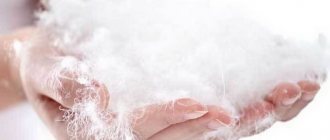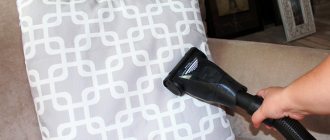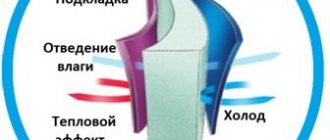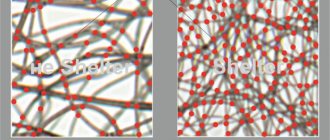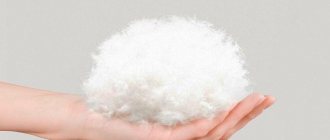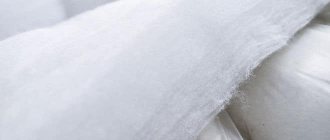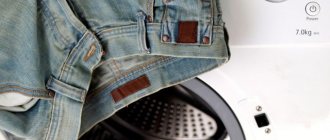What is the density of insulation in a down jacket?
Density of insulation in a down jacket (Fill power 600/700/800, etc.) The main indicator of the quality of down is its elasticity (density), so do not hesitate to wrinkle the product in your hands. ... This indicator should be at least 550 - this is a guarantee that the down jacket will retain its original appearance for a long time.
Interesting materials:
When does sea buckthorn occur? When is the full moon? When are air tickets on sale? When is there a trinity? When are there discounts on planes? When to take chrysanthemum cuttings in the fall? When to Cut Multiflora? When is the canon of Andrei Kritsky read in 2022? When will advance payments be given to state employees for 2022? When will the military pension for May 2020 be given?
What are they and how do they differ from previous analogues and natural fluff?
Time flows relentlessly and inexorably, days, weeks, months, seasons change... A beautiful winter is creeping up. Living in such harsh weather conditions as in Siberia obliges us to have certain skills in choosing ways to protect ourselves from the cold.
One of the most popular types of outerwear, combining such important qualities as: practicality, comfort, warmth, lightness and affordable price, are down jackets. The name, in this case, speaks for itself. To protect the body from exposure to low temperatures, previously only natural down was used as a heat-insulating filler. But in the modern world there are also many other materials that are created using innovative, progressive technologies.
So let's look at what types of fillings for down jackets exist now and compare the characteristics so that you can be prepared when choosing such an important wardrobe item.
Feather
To produce down insulation, the down of waterfowl (mainly northern birds) is used. This is the part of their plumage that creates a layer between the skin and feathers and protects the body from hypothermia or overheating.
Unlike a feather, down does not have a long hard shaft, but consists of a core and barbs extending from it, which interlock with each other and form a rounded shape of the down. The down of the northern bird, eider, is most valued, followed by goose (white goose) and duck.
Advantages
This material consists of down and bird feathers, and its quality directly depends on their percentage. The more fluff, the better the performance will be. The most expensive one, which contains at least 99% down, has the following properties:
- ease. Since the heaviest part of the feather - the spine or shaft - is not present, the products are very light and flexible; strength and durability. Typically, the service life of products is 15-20 years; hygroscopicity. Absorbs all the evaporation of the human body, dries out over a period of time; low thermal conductivity. Thanks to the large number of fluffs that touch and form many cavities filled with air, the insulation provides reliable protection from the cold; elasticity. When squeezed, the fluffs fit into each other, the material does not feel, but crumples and quickly restores its shape, allowing you to preserve the maximum number of air layers inside.
How to care for a down jacket or jacket with bio-down?
It is not recommended to frequently wash clothes filled with bio-down. Despite its resistance to moisture, this material will definitely not withstand weekly washing. If a small stain appears on the fabric, although the item looks quite neat, it is enough to wash it.
Wash or dry clean?
Down jackets tolerate both home washing and dry cleaning. The services of a specialist are required in the presence of heavy soiling, when there is a risk of spoiling the item due to the use of strong stain removers and the presence of permanent inserts made of natural fur or other delicate materials. What can't you do with such things? Regardless of the cleaning method, they cannot be soaked, washed in hot water, or kept wet and crumpled in a basin - you must immediately remove the moisture and put them in a well-ventilated place to dry.
Rules for washing in an automatic machine
Despite the high wear resistance of the material, it is necessary to carefully care for it so that it lasts as long as possible. Rules for machine washing a down jacket:
- preliminary inspection of the item for contamination - if necessary, remove stains using laundry soap or organic stain removers;
- the optimal water temperature for washing is 30–40 degrees;
- acceptable washing mode is “delicate”;
- use only liquid detergents and softening rinses;
- using the additional rinse option - to better rinse out the detergent components and prevent the formation of white stains on the fabric;
- refusal to spin - remove moisture only manually.
Recommendations for hand washing
To wash a down jacket by hand, you need:
- shake it off the dust and beat it well;
- carefully inspect and, if necessary, remove contamination using special means;
- pour warm water into a container and dissolve liquid detergent;
- gently, as if kneading dough, wash the product;
- Without twisting, lightly squeeze out the liquid;
- Rinse several times and gently wring out the item again.
Regardless of whether the down jacket is washed in a machine or by hand, you need to lay it out on a flat surface on a thick fabric so that it absorbs water. To do this, you need to turn the product over several times. Next, the item is hung on hangers and put away to dry in a well-ventilated place away from direct sunlight and heaters. It must be remembered that the filler is deformed when exposed to high temperatures.
Varieties and characteristics
Clothing with Thinsulate has special “3M Thinsulate Insulation” labels, which differ from each other in color. The manufacturer produces the following series of insulation:
- Platinum
- Warmth plus Additional Features
- Featherless
- LiteLoft
The black and gray Platinum line labels are common on outdoor apparel and footwear. The line includes the following types.
Flex has fibers with increased elasticity, so clothing does not restrict movement.
X-Static is ideal for high physical activity, as the ionized fibers in its composition are responsible for inhibiting the growth of bacteria that cause unpleasant odors.
FR is designed for workwear and withstands contact with fire and electricity.
Note! Each product is marked indicating the type of insulation.
Unlike the Platinum line, Warmth plus Additional Features are widely used in sewing clothing and footwear for outdoor activities, fishing, hunting, and home textiles.
- Thin, light, warm - one of the first types of this insulation, thin with high heat retention rates.
- Extra Warmth has a lower price; products using it are slightly thicker.
- Thinsulate with recycled fibers has some fibers made from recycled materials.
- Ultra for footwear and Ultra Extreme Performance are widely used in footwear production, as they contain a large amount of olefin fibers, which increase resistance to deformation. These shoes are ideal for low physical activity.
Featherless is a new synthetic analogue of down, which has all its properties, but does not lose its properties even when clothes get wet.
LiteLoft is distinguished from other types by the structure of the fibers: thin ones increase the area and amount of warm air, thicker ones increase the volume of insulation. Resistant to compression, easily restores its original shape.
Additional Information. Varieties of filler not classified in the listed categories are marked with a common black and white label. These include the raw materials used for sewing blankets.
What temperature is bio-fluff designed for?
At what temperature can artificial down items be worn? This depends on human heat transfer, the density of the upper material and the thickness of the insulation. Depending on the density, the packing can withstand the following temperature conditions:
- thin, up to 100 g/sq. m and -10 degrees – used for sewing demi-season clothing;
- medium thickness, up to 200 g/sq. m and -15 degrees - the most popular type of padding used in the manufacture of winter outerwear;
- dense, up to 400 g/sq. m and -35 degrees – used for sewing workwear.
What types of fillers are there? How are they fundamentally different?
Types are divided into 2 groups: natural and artificial. Each has its own pros and cons.
The first group consists of natural fluff. It is a popular filler, where swan or goose down, as well as duck or eider down, are used as insulation.
The benefits of down are as follows:
- high heat saving ability
- softness
- ease
The disadvantages of natural down are:
- fragility
- special storage and cleaning conditions
- loss of shape
- possibility of allergic reactions
- high price
Natural down
Among artificial fillers, Thinsulate, which has caused a stir in the textile industry, stands out. From the name (thin-thin, insulation-thermal insulation, English) we get thin thermal insulation. Interestingly, this technology was first introduced in 1978 by the American, as part of the NASA program, as a material for astronaut suits. Consists of microfibers that are 50 times thinner than a human hair. Refers to materials with a high heat retention rate. At a certain density it can protect against temperatures down to -60°C, and is used to create high-quality mountaineering equipment. But let’s look further at the advantages related to outerwear itself.
Advantages of Thinsulate:
- unique thermoregulatory properties
- the lightest of all artificial fillers
- almost 2 times warmer than down
- hypoallergenic
- durable
- does not lose shape
- ecologically pure
- indispensable in regions with high humidity
- perfect for children's clothing
Disadvantage of Thinsulate:
- slightly higher price compared to other non-natural fillers.
Filler Thinsulate
Also among fillers with a high degree of thermal insulation is BioPooh Sustans, a patented biopolymer, a revolutionary technology from DuPont-Sorona (USA-Japan). The first high-tech material, partly composed of regularly renewable plant components. The process of creating this fiber is biologically friendly. In this regard, DuPont was awarded the Presidential Award in America for their contribution to the creation of environmentally friendly production.
The advantages of BioPooh are:
- ease
- softness
- elasticity and resilience
- innovative thermal insulation properties
- super strength
- looks beautiful, elegant and not too bulky
- Great for children's down jackets and overalls
- can be washed at home
- environmentally friendly material
Disadvantage of BioFuzz:
- in terms of thermal insulation properties it is close to natural down, that is, inferior to Thinsulate
BioDown SUSTANS
There are also many artificial fillers for down jackets that are already outdated and no longer relevant, such as padding polyester, synthetic padding, holofiber (fiberskin, fibertek, polyfiber) consisting of different shapes of polyester fibers. To provide thermal insulation comparable to bio-down and Thinsulate, they are required in larger volumes, so they make the product much heavier.
In general, now, having come to an outerwear store for such an irreplaceable item as a down jacket, we can already navigate what the different fillers are and make the right choice. Some are attracted by naturalness, others by a high degree of thermal insulation, and for others, price and practicality are more important. Winter is ahead, it’s worth meeting it prepared, and using the latest advances in science to warm yourself and enjoy this magical time of year in peace.
Rules of care
- After washing, a product with Thinsulate retains its shape. You can wash it on a delicate cycle at temperatures up to 40 degrees with a spin cycle, follow the recommendations on the factory label.
- Membrane clothing with Thinsulate must be cared for using special detergents; these can be purchased at sports stores.
- It is better to dry on a horizontal surface away from heating devices, preferably ironing without steam.
- Can be packed in vacuum bags, the properties of the insulation will not change. The fibers are connected by thermal bonding, thereby maintaining elasticity.
Important! How warm a jacket will be in winter depends on the frequency of stitching. A product with thinsulate should not be quilted often; the distance between lines should be at least 12 cm, then warm air will be retained.
What is it about Thinsulate that makes it popular? The insulation has the thinnest hollow fibers in the world, in addition to this, their area is tens of times greater than the area of fibers of similar materials. These characteristics make it as efficient as possible. If there is no 3M brand label, but the label says “polyester,” this does not guarantee that Thinsulate was used as insulation. In this case, you need to ask the seller for certificates, since only the original meets the qualities described above.
Reviews
Irina: Last winter I bought myself a down jacket with Thinsulate. I was almost sure that there would be no difference compared to padding polyester, and it was purely a matter of advertising. The down jacket turned out to be very warm and surprisingly weightless, so I'm glad to be wrong.
Maxim: I have boots with Thinsulate, I bought them at a sports store for outdoor activities. I wear them every day because I have to walk a lot for work. I won’t say exactly how many grams of filler there are, but my feet are warm even at -30 degrees.
Marina: I have a 4-year-old child, a very active boy, ready to walk in any weather. Last winter I wore a jacket with natural down, I was tired of washing and fluffing it. This year I bought him a jumpsuit with Thinsulate for the winter, I already appreciated the ease of washing and the fact that the child does not sweat in it.
Application
In addition to winter jackets and down jackets, bio-down is used in making winter shoes, gloves, warm pants and hats. At ski resorts and on hiking trips, almost all paraphernalia consists of sustans. Thanks to the light weight of clothing, it is more convenient for a person to move around the area and not freeze.
The material is also used to fill bed linen. Blankets and pillows are light and elastic, and at the same time always remain the same shape. In addition, bio-fluff is used in children's toys and women's cosmetics.
Thinsulate
Now on sale you can find many different synthetic insulation materials with different names. Initially, their creation had one goal - to simplify and reduce the cost of producing warm clothes.
To date, scientists have managed to create unique new generation fibers that can replace natural ones and surpass them in some parameters. For example, modern fiber Thinsulate TM (Thinsulate TM).
Advantages
Thinsulate is distinguished by its special fiber fineness - only from 2 to 10 microns (tens of times thinner than a human hair). They are intertwined and in some places connected by thermal bonding. This is one of the main advantages of the material: even in a small volume, a huge number of air layers are formed, which provide the best thermal insulation (can withstand frosts up to 60 degrees).
- lightness and small volume. There are several varieties of Thinsulate, some of them have particularly high compression properties, products with them take up very little space when folded, and when unfolded they provide good thermal insulation (important for tourists and athletes); the fiber practically does not absorb moisture at all (absorption coefficient less than 1% of its own weight); dries quickly. Can be used in conditions of high humidity; elasticity. Easily wrinkles and restores shape; strength and durability. Resistant to repeated washing, does not shrink (does not feel), it can be washed and dried in a machine; hygiene and hypoallergenic. Due to excellent ventilation and quick drying, the material is not a favorable environment for the life and proliferation of bacteria. Does not cause allergies.
Over the course of several decades of operation, no deficiencies were identified in Thinsulate. Its only disadvantage is its high price compared to other synthetic fillers.
